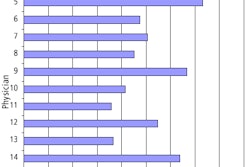On the basis of job advertisements in the journals Radiology and the American Journal of Roentgenology, the market for radiologist hires in the U.S. has decreased steeply since 2002, according to research presented at the Educational Symposia's Economics of Diagnostic Imaging conference last week in Arlington, VA.
"Although the number of employment ads has decreased, there has been an increase in radiologist workload and an overall increase in physician RVUs (relative value units) per procedure as well," said Jonathan Sunshine, Ph.D., senior director for research at the American College of Radiology (ACR) in Reston, VA.
Sunshine shared his research into the current dichotomy in hiring practices: an increase in demand for radiologist services coupled with a decrease in the number of professional personnel.
Assumptions
Sunshine and his colleagues examined eight possibilities for the downward trend in the number of job listings per job seeker in the ACR Professional Bureau:
- Delayed retirement brought about by the stock market decline in the past few years.
- Radiologists are working longer hours or are taking shorter vacations.
- There is increased productivity on-call through teleradiology and the use of nighthawk services.
- There is an outsourcing of call to foreign radiologists, either U.S. board-certified radiologists working overseas or radiologists from other countries.
- Imaging utilization in the U.S. is no longer growing.
- Radiologists' turf is eroding so fast that the total workload for radiologists is no longer growing.
- Residents are no longer taking fellowships, and are entering the workforce directly after passing their certification boards.
- Radiologists have higher productivity and are accomplishing more work per hour.
The researchers found that retirement among radiologists, although delayed by a few, has remained at a fairly constant rate. Sunshine reported that radiologists age 45 and over make up 68% of the current workforce.
"In reality, there's been little change," he said.
Radiologists are working longer hours than their colleagues did nearly a decade ago, an average of 53 hours per week in 2003 compared to 50 hours per week in 1995. However, that has been offset by an increase in the average number of annual vacation days taken by today's radiologists compared to their colleagues of the 1990s (34 versus 26 days).
"We've seen an increase in the annual hours worked of approximately 6%, but this is somewhat offset by a decrease of approximately 4% in the number of annual days worked," Sunshine noted.
Teleradiology, although prevalent in practices with multiple radiologists, has seen only a modest increase in use, from 71% to 73% of practices, since being surveyed in 1998. Nighthawk services to groups outside a practice were used by only 18% of the radiologists, he reported.
The outsourcing of call to radiology groups outside the U.S., although widely reported in the media, was deemed an insignificant factor according to Sunshine's research.
"The outsourcing of call to foreign radiologists was too small to be of substantial effect," he said.
There are fewer residents taking fellowships than there were in the mid-1990s, Sunshine noted. Approximately 60% of the radiology residents were taking fellowships in 2003, compared to about 80% of the residents who took fellowships in the mid-1990s.
"This represents about 200 more radiologists working in practice than are taking fellowships," Sunshine said.
Although there has been a slight reduction in the growth rate of imaging utilization, according to data from the Medicare database, usage is still increasing.
"In 2001-2003, imaging utilization increased 2.3% annually," Sunshine said. "This represents a downturn from the 4.8% annual growth rate of imaging from 1998-2001, but it's still growing."
There has been an influx of nonradiologists performing diagnostic imaging studies and encroaching on radiology's turf, but radiologists have seen an 18% increase of procedures in 2002-2003 compared to data from 1995-1996, according to Sunshine.
What stood out to Sunshine and his colleagues in their data analysis was that radiologists were demonstrating higher productivity; they obviously were getting more work done on an hourly basis, he said.
For the long term, radiologists should have very little need to worry about finding employment.
"The workload is growing faster than the number of radiologists," Sunshine said. "It's growing about 4% annually in the number of procedures and about 6% in RVUs. However, the number of radiologists in practice is only growing about 1% annually."
According to Sunshine, radiologists are handling the increased workload by getting more work done each hour; in essence, by working smarter.
"We've categorized working smarter as the use of purportedly productivity-promoting processes and paraphernalia as well as practices' parameters," Sunshine said.
Measuring productivity
To measure radiologist productivity, Sunshine and his team at the ACR conducted a stratified random sample of all U.S. radiologists and received a 63% response rate. They then weighted the responses to make the data represent all U.S. radiology practices, and ended up with approximately 900 respondents with relevant data.
The group looked at the categories of PACS, wet-read phone lines, support staff for hanging film, nurses or physician assistants (PA) for tasks beyond technologists, voice-recognition software, templates or standard report language, teleradiology, and other for its estimated effects of process and paraphernalia survey.
"If you use in your reports templates or standardized language, we're finding an 8% gain in productivity in that," Sunshine said. "If you're using teleradiology, compared to practices that don't, we're seeing a 12% gain in productivity with its use."
PACS showed up as increasing productivity approximately 5%, while those practices still using film estimated a 12% increase in productivity by having staff dedicated to hanging films. Voice-recognition software came in at a 4% increase, while a wet-read phone line added 3% to estimated productivity. The category labeled as "other" produced a 12% uptick, and the use of nurses or PAs was reported as 0.2%.
Sunshine, noting that the results were mixed, speculated that there may have been too many independent variables and consequently too much "noise" in the data. He also suggested that merely having a process or paraphernalia may not be enough.
"Maybe it's not merely having or doing something that matters, but having or doing it right," he noted.
Sunshine offered five practice implications from the survey data:
- Go with the items that will have a clear effect on the productivity of your practice.
- Check with current owners before buying into a process or paraphernalia.
- Find out what features are available; visit others and watch the process or paraphernalia at work.
- Find out what's needed to make the items work well.
- Monitor how well the process or paraphernalia is really working in the practice.
On the practice parameter side of the survey, Sunshine reported some interesting results with regard to radiologists who work in a fixed location compared with radiologists who work in as many as three different locations on a weekly basis.
"We found that the radiologists who work in additional locations during a work week to be approximately 3% more productive in the rate of their procedures per hour," he said.
By Jonathan S. Batchelor
AuntMinnie.com staff writer
November 2, 2004
Related Reading
ABR's recertification program spurs confusion, complaints, October 19, 2004
On getting a job in radiology: a primer for residents and fellows, October 18, 2004
Survey says rads are working harder for less, April 15, 2004
Survey predicts big loss of practitioners to retirement, changing work patterns, December 23, 2003
Salary offers to radiologists jump 11%, July 14, 2003
Copyright © 2004 AuntMinnie.com



















